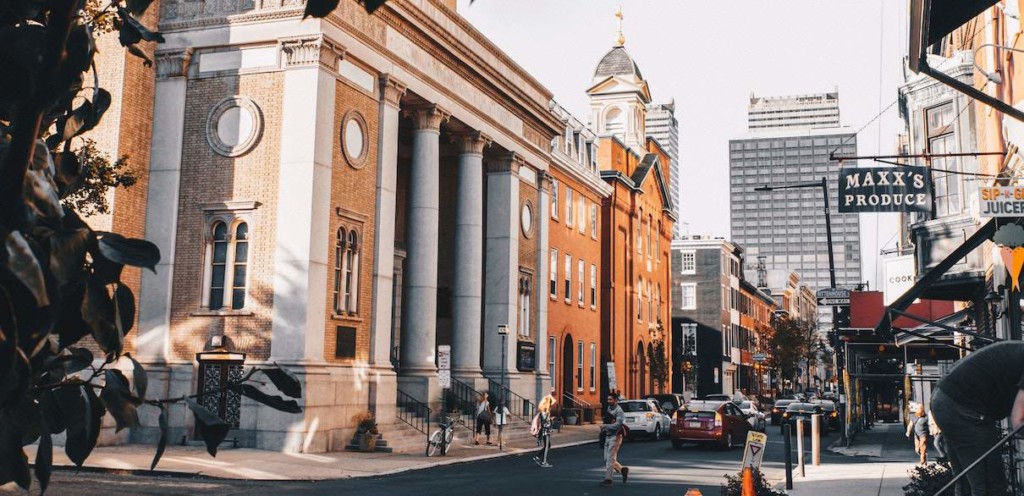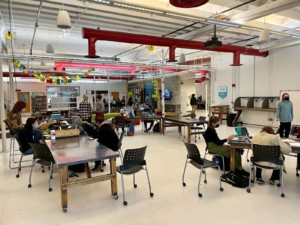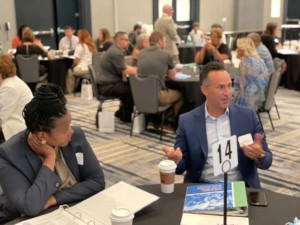Restorative Practices at Building 21 Philadelphia

By: Don Spangler and Crystal Cubbage
The Philadelphia Learning Collaborative (PLC) is a grassroots nonprofit that exists to create the conditions for student-centered, deeper learning progressive K-12 educators and schools to thrive in Philadelphia.
Based in Philadelphia, Building 21 is a non-profit that partners with school districts and communities to design, launch, and operate innovative schools. In addition to the two “Lab” schools that Building 21 operates in partnership with the School District of Philadelphia and the Allentown School District respectively, we also work with schools and districts that are transitioning to competency-based education through our affiliate model. Building 21 collaborates with our partners, school leaders, staff, students and families to realize communities rooted in personalized competency-based learning, strong relationships, and adult development.
David Sparrow, B21 Director of Behavioral Health, who leads the schools Restorative Practices initiatives, came to the school after years of experience at a Wilmington, DE school for youth who had been removed from their home schools for disciplinary reasons. “It was a tough school,” Sparrow recalls, but this was primarily because almost every student had some form of mental health diagnosis, had grown up in a high poverty community, and had experienced trauma that contributed to his or her behavioral issues. Eager to learn more effective approaches for these students, Sparrow and a colleague attended workshops at the International Institute for Restorative Practices (IIRC), where they witnessed firsthand how restorative practices can transform even the most challenging schools. Both were enthusiastic about the potential of the practices and eager to see how they could benefit the students in their school.
Several years later, Sparrow was interested in returning home to Philadelphia and learned that Building 21 was seeking candidates for a social worker position. He interviewed with Dr. Laura Shubilla, co-founder of Building 21, who also had a social work background and was eager to consider restorative and trauma-informed approaches. She shared some of the struggles the school was experiencing with culture and discipline, and they discussed what restorative approaches might look like at B21. Based on these conversations, Sparrow was hired as a social-emotional support specialist for the 2015-16 school year (B21’s second year) and was tasked with developing a plan for implementing restorative and trauma-informed practices at the school.
Rolling Out Restorative Practices. The use of restorative practices “calls for everyone in the building to be restorative towards another, not just staff and students,” says Sparrow. “It’s across all relationships in the building and involves all school and community stakeholders.”
Staff Training. The 2015-16 school year was focused on laying the groundwork for implementing restorative practices, helping staff to understand and buy into the approach and to develop a common vision for implementation. “You have to start with staff and help them understand both the practical and philosophical implications of this work,” Sparrow explains. “It’s a huge commitment, and there’s a lot you’re going to have to go through together.”
B21 started by providing professional development in restorative practices for teachers and administrators during its Summer Institute (a two-day, off-campus retreat), as part of faculty meetings prior to the beginning of school, and then through regular professional development sessions during the school year. Sparrow also provided coaching during regular classroom periods, tailored to specific needs and requests of teachers, e.g. on circles, affective statements, and other forms of positive interactions with students.
“Eighty percent of restorative practices is just about cultivating healthy and productive relationships,” says Sparrow. “The human relationship has to come first. You’re not here to teach math, you’re here to teach math to young men and women.”
Upfront Discussion with Students. Restorative approaches are presented and explained to students during orientation, first by climate and culture staff as disciplinary alternatives, and then by teachers as proactive strategies (circles and conference) in classrooms. At back-to-school night, teachers, administrators, and support staff discuss with parents and guardians how restorative practices are implemented, the roles each of them plays, and how parents and guardians can help to make these processes successful for their children.
At the classroom level, Sparrow explains, “you can start with something as simple as a temperature check in a circle — e.g. how are you feeling? What are your goals for the day, and what do you need to meet them? Then over time, as trust builds you can gradually scaffold questions and issues until you’re getting at the heart of some very challenging issues.”
Even so, sometimes even the simplest question in a circle can lead to unintended consequences. Sparrow relayed a story from his Delaware school in which the daily circle question was what is your favorite color? Simple enough — except that one of the students was gang-involved so “colors” triggered a very specific and emotional reaction that led to a much more in-depth and personal discussion than the facilitator had intended.
Necessary but not Sufficient. As the restorative practices roll-out continued, it became clear to Sparrow and his colleagues that there were clear links between these and parallel efforts underway in the school to promote trauma-informed approaches — which are grounded in an understanding of how trauma and stress can perpetuate themselves in students’ lives and behavior; and cultural competence — which speaks to the importance of understanding the cultural norms and values that students bring with them to the schoolhouse door.
“We came to understand,” Sparrow explains, “that we can’t be trauma-informed without being culturally competent, and that we can’t be restorative if our work with students and with each other isn’t trauma-informed. These three things are inextricably linked.”
Sparrow offered an illustration. A white female teacher confiscated a black male student’s cell phone during class. At the end of the period, he pushed past her without comment and forcefully took his phone from her desk. Upset and frightened by the confrontation, the teacher discussed the matter with the principal, who asked her how she would prefer to handle it. The teacher replied that, up to this point, she and the student had had a good relationship, so she would prefer to discuss and attempt to resolve the situation rather than make it a disciplinary issue. She recruited another teacher to serve as a facilitator, held a restorative conference, and after a hard but ultimately positive conversation the matter was amicably resolved.
“This situation,” Sparrow explains, “demonstrates how all three concepts intersect.” The student, based in part on feeling disrespected and misunderstood, acted inappropriately. The principal responded restoratively by trusting the teacher to find an appropriate response. The teacher demonstrated cultural competence by recognizing that her fear was exacerbated by unconscious racial bias, and also acted restoratively in opting to talk through the issue with her student. The student acknowledged the pain he had caused her, the teacher came to understand the underlying issues that prompted his actions, and both left the conference with a stronger relationship and mutual trust.
Operationalizing the TriChange Model. In 2018, B21 formally established the TriChange Model, integrating all three domains as foundational elements in the school’s approach to teaching and learning. In short, the model was grounded in common understandings of and commitments to:
- building and sustaining healthy relationships among all school stakeholders
- addressing trauma and its impact on the lives of all community members
- respecting the cultures of others and its importance in their lives
The Model is overseen by the TriChange Steering Committee, composed of a teacher from each grade level, the coordinator of school advisories, and Sparrow, which meets weekly to monitor implementation and discuss strategies for improvement. Grade-level members are selected based on their interest in one or more of the domains, and their desire to grow as educational leaders. Teacher members of the steering committee are particularly important, Sparrow explains, “because they will often have strong credibility and influence with their peers in implementing elements of the Model.”
Steering committee members also lead building-wide Professional Learning Communities (PLC), in which all staff members participate. The PLC meets monthly to discuss specific readings in the three domains, address issues they raise, and consider practical applications in classrooms and throughout the school.
Steering committee members also provide classroom-based coaching sessions to address specific issues around model implementation. Coaching is provided based primarily on the needs of individual teachers, i.e. those who are strong in all three domains will require fewer sessions. Coaching varies widely based on teacher needs and preference, e.g. how can I incorporate content into my circle strategy, or how can I deal with negative racial stereotyping in popular fiction and what books would be more positive?
The steering committee also establishes specific school-wide annual goals relating to the TriChange Model. Goals for the 2019-20 school year include:
- Developing a diversity, equity, and inclusion statement based on input from the entire school community, which defines specifically what cultural competency means at B21 to ensure common understanding and collective accountability.
- Redesigning the Advisory model to focus on building relationships through restorative approaches, and more broadly to serve as the hub of school culture where all three domains are addressed and reinforced daily.
- Creating a framework for formal restorative conferences, which are necessary when all other attempts at reconciliation and repairing harm have failed and a structured meeting is required with the victim, the offender, and other stakeholders such as parents, staff, and/or officers of the court.
Outcomes. “During the first year, things continued to be pretty chaotic,” Sparrow says, including significant numbers of suspensions. “But in the last couple of years we’ve seen drastic reductions in suspensions, other disciplinary actions, and incidents of disrespect.” Further, attendance is at an all-time high and the graduation rate for 2018-19 reached 88%, significantly higher than that for similar high schools in PA (71%), and for the school district (69%, for both district and alternative high schools).
“These improvements,” Sparrow believes, “have everything to do with relationships and with our school community buying into the TriChange Model and the culture it promotes. We’ve invested in staff training and hired more support staff, and the culture of our building has changed significantly for the better.”
Recommendations. Sparrow offers several recommendations for other schools interested in implementing integrated approaches to restorative practices, trauma-informed care, and cultural competence.
- Investment from leadership is key. The primary reason this work has been so successful at B21 is that senior leaders have bought into it and invested in training, new staff, and overall support for implementation. If leaders are not invested, it’s not going to work.
- Designate a point person to lead the effort. Identify an individual with experience in restorative approaches and provide them with in-depth training (e.g. IIRC or other resources). Then, invest in a team of people and give them the authority to implement the model, taking into account the needs of faculty and administrators.
- Ensure that school leaders model restorative approaches. Restorative approaches are not just focused on students but also extend to the ways that members of the school community interact with one another. As leaders begin to practice these techniques with staff, everyone in the school community can begin to see and understand the benefits.
- Hold yourself accountable. Schools committed to this work must eventually ask themselves, what do we look for to determine if we’re truly being restorative, trauma- informed, and culturally competent? What do we need to do differently? Answering these questions will involve rigorous self-analysis, including reconsideration of policies, protocols, programs, and daily practices.
The real key to success, Sparrow says, is building relationships across the school community. “If a student knows they’re cared about, then it makes all the difference. Reach the person first, and then you can teach him or her anything.”
For more, see:
- Building 21: Bold Outcomes, Innovative Model, Next-Gen Network
- Getting Clearer: Educator or Color
- We Can’t Put the Genie Back in the Bottle: Designing Next-Generation Education in the Time of Crisis
This post was originally published on phlcollab.org
Don Spangler is an independent consultant.
Crystal Cubbage is the Collaborative Director of the Philadelphia Learning Collaborative.
Stay in-the-know with innovations in learning by signing up for the weekly Smart Update.






0 Comments
Leave a Comment
Your email address will not be published. All fields are required.